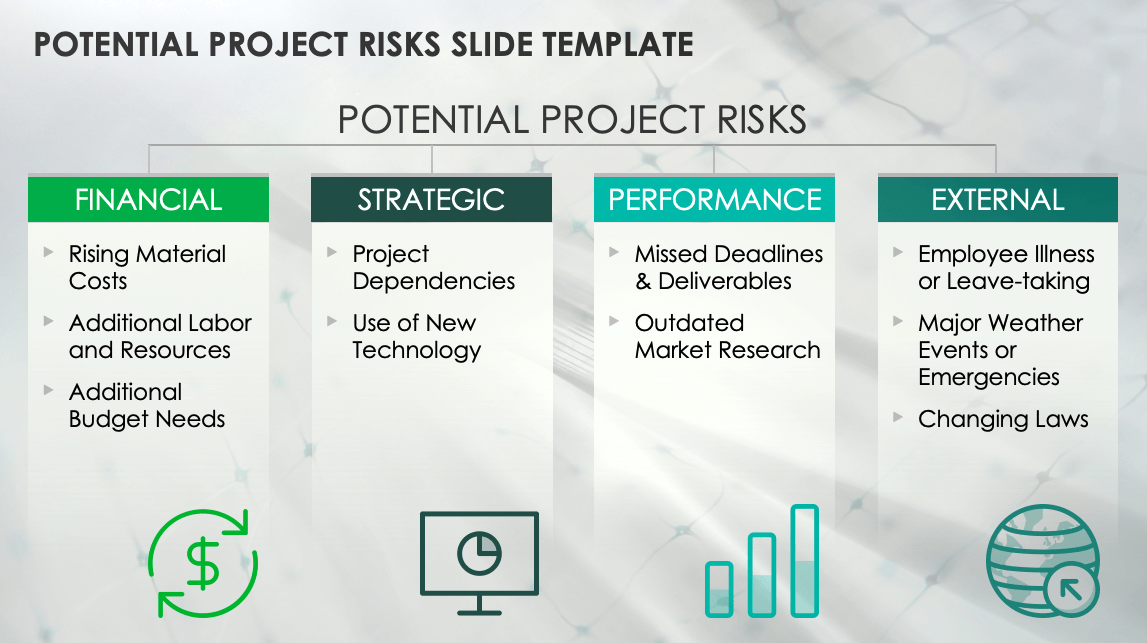What Are Risk Categories?
A risk category is a high-level classification of project management risks. The two overarching risk categories are project-level risks and business-level risks, which can be broken down into subcategories. Risk categories account for both internal and external sources of risk.
- Project-Level Risks: Project-level risks have the potential to affect results at the project level. Project risks can include factors related to budgeting, resource management, scheduling, and more.
- Business-Level Risks: Business-level risks have the potential to affect the overall operations of a business. These include factors such as project prioritization, governance, customer satisfaction, and workforce risks. A company’s risk management plan will usually address business-level risks implicitly.
These risk categories can each be broken down on each level into financial risks, strategic risks, performance risks, and external risks.
Types of Project Risks
At the project level, risks can come from financial decisions, project management strategies, project performance, or external sources. These four risk types have varying consequences based on severity. It is important to consider all four in your risk mitigation strategy.
These are the four types of project-level risks:
- Financial Risks: Financial risks involve a project’s monetary factors. These might include the rising costs of materials, unrealistic budgets, higher-than-expected time or labor requirements, lower-than-expected sales numbers, or the failure to secure sufficient funding.
- Strategic Risks: Strategic risks involve the strategies chosen to complete a project. These might include your project management methodology, project planning techniques, daily operations, company culture, employee satisfaction and retention rates, project dependencies, or investment in technology.
- “The risks you might encounter can vary greatly in the chaos of our culture and environment,” says Donald Bloom, the CEO of Prime Retail Services, “but the greatest risks each company faces are the actions of the people in project authority. Their training and attention to planning a project completely and executing according to the company processes is the cornerstone for success.”
- Performance Risks: Performance risks involve the overall project performance. These might include unclear expectations for deliverables, undefined KPIs, outdated market research, or underperforming product lines.
- “Some projects have emerging requirements, meaning there is no way to get all the requirements at the beginning of the project because people are still figuring out what they want,” explains Angela Druckman, Owner of The Druckman Company. Projects with clear guidelines and requirements will run into fewer performance risks than those without them.
- External Risks: External risks come from less predictable outside sources. External risks might affect performance and results at the project or business level, depending on their severity. These might include employee illness, major weather events or emergencies, legal decisions, market volatility, and supply chain risks.
To learn more about how to manage project risks, read this comprehensive guide to project risk management.
Potential Project Risks Slide Template
Download Potential Project Risks Slide Template
Microsoft PowerPoint
| Google Slides
Include this potential risks slide template in your project presentations to help you identify and communicate project risks. The template breaks project risks into four categories: financial, strategic, performance, and external. The template comes partially filled with sample text to help get you started but is fully customizable.
Examples of Major Risks in Project Management
While all risks can impact a project’s performance, some can stall or halt a project entirely. The most potentially impactful project risks include major budget overages, workforce volatility, production and procurement problems, scheduling and resource mismanagement, and organizational changes.
Major Budget Overages
Project budgets are one of the most critical constraints to consider when planning a project. A project that goes over budget has the potential to affect the financial solvency of the entire business.
Budget overages can result from countless situations because every part of a project costs money. With improper planning, teams can easily overspend on items such as material sourcing, labor, or other necessary project elements that were not included in the initial budget.
Imagine a company that has accounted for its project expenses down to the dollar. They have done a great job of anticipating all of the line items involved in the successful execution of their project but failed to account for emergency expenses or overages. Halfway through the project’s lifecycle, the team discovers that a measurement was off, and completed work must be redone. Because the project managers failed to account for this possibility, there is no money left in the budget to repeat the work and no way to salvage the completed work to the customer’s satisfaction. The project will now cost far more than anticipated, and employees will need to work longer hours to get the deliverables back on track.
“More accurate budget projections improve the quality of your data,” says Jeff Mains, the CEO of Champion Leadership Group LLC. “Improved data quality is, without a doubt, one of the most critical components of various risk management practices.”
Managing a project’s budget is an active process that begins with research and planning. Create a detailed budget based on careful research. Use data from previous projects, as well as real numbers that you find in your research, when creating your estimates. Always include extra room in your budget for emergencies, and keep your budget sheet updated with current costs as the project progresses.
Retention of Skilled Employees
Employees are a critical part of any business, so it is important to ensure that they are satisfied with their work. High employee turnover causes many problems and is a major source of project risk.
Workforce volatility occurs when low employee satisfaction results in high employee turnover. A constantly churning employee roster makes it difficult to plan and schedule a project, slows progress on projects, and prevents a team from developing a strong, consistent work ethic.
Imagine a scenario in which a highly skilled engineer leads a department that assembles machines for a company. The engineer has been with the company for decades and is knowledgeable, skilled, and likes their job. Over time, they are the only engineer left at the company with the knowledge to build these machines, and to teach others to do so. Rather than putting a training program in place for new engineers, the company expects them to train under the senior engineer, who is still the only one who knows how to assemble the machines. Now the senior engineer is expected to both build the machines and train others to do so and asks to be compensated for the extra workload. The company says no, so the senior engineer moves on, leaving a company with junior engineers who do not have the knowledge needed to assemble and upkeep their machines, and no one to train them to do it.
A highly skilled workforce is a valuable asset. Employee satisfaction is essential to maintaining a skilled workforce, and a dissatisfied workforce costs a company money. Job satisfaction is higher with well-compensated employees, so it is in a company’s best interests to spend the time training valuable prospects and compensating them appropriately. Satisfied workers will work harder and are less likely to seek alternative employment, which means your teams are less likely to experience major changes in the middle of projects.
Procurement and Production Complications
For projects that involve the manufacture of physical products, acquiring base materials is essential. If you are unable to source the materials you need to produce your product, your project progress will grind to a halt.
Imagine a company that fabricates custom wood furniture. A customer sees a piece in a showroom and orders a dining table. The salesperson, having sold dozens of end tables, provides the customer with a quote and delivery date based on their experience and signs a contract with the customer. When it is time to source the wood, however, they find that wildfires have destroyed most of this tree type. Now, the price of that wood has more than tripled, and it will take an extra month to deliver the wood. The company is stuck with a contract for an order that is going to deliver a month late and make them no profit.
Supply chain issues can be difficult to predict. Sometimes, even when materials are available, they are prohibitively expensive. You might combat these issues by diversifying the sources of your materials or by maintaining a stock of materials in excess of your current needs. In addition to cost, supply chain issues can also cause delays that decrease customer satisfaction. Build room into your schedule for emergencies, and be as transparent with your customers as possible when roadblocks arise.
Resource Mismanagement
Prioritizing and scheduling projects while managing resources is a difficult but necessary skill. If your labor and financial resources are not balanced appropriately, it can result in disaster for both new and ongoing projects.
Imagine a growing coffee chain that is opening a new store in a popular location. They have opened new stores before and have an idea of the labor needs. They set a date to open, start working on the build-out inside the storefront, and begin hiring staff for the new location. By the time the open date arrives, they are unable to find and train quality employees, so they decide to take one employee from each existing store to staff the new one. Each store that has had an employee removed is under more strain due to missing labor, while the new store is busier than anticipated and needs even more labor. After six months, employees are quitting in droves to find work that is less stressful, leaving the company with even fewer resources for existing stores.
To mitigate the risk of overusing your resources, implement resource management processes. Project resources include money, materials, equipment, and people. Your organization should have methods in place to determine which resources are available and in use, as well as the resource needs of newly proposed projects. Companies should also work to ensure that they never use more resources than they have available. They should also keep resources in reserve for emergencies.
Organizational Changes
Changes in leadership can also bring changes in priorities and funding. Projects that were once well funded can be lost in the shuffle, shelved, or even canceled outright amid sweeping organizational changes.
Think about a company with a CEO who is a recreational runner. They are approached by a local marathon to help sponsor an afterparty and happily accept. The company does this for a few years because they feel it is a good advertising opportunity and because the CEO participates in the marathon. Eventually, the CEO retires, and the company hires a new person for the position. When they review the annual budget, they deem the cost of the marathon afterparty unnecessary. The team working on next year’s party is then reassigned to another project.
Organizational changes can be highly beneficial to a business because they allow companies to focus on new, more profitable ventures. Reprioritizing portfolios is a great way to find places to save money and better utilize resources. Sometimes, this means sacrificing projects for which many resources and great effort have already been expended. It is in a company’s best interests to weigh the pros and cons of ending any ongoing project to determine the impact of that wasted effort.
Examples of the Most Common Project Risks
Not all project risks threaten to derail a project entirely, but they should still be taken seriously. Some of the most common project risks include scope creep, low sales performance, inefficient project management, and IT and construction risks.
Project managers should work to mitigate potential risks when possible. While most risks are relatively minor, multiple risks can quickly add up to become a more serious threat to the project. We’ve outlined some examples of common project risks, with tips to mitigate or avoid them when possible.
Scope Creep
Scope creep is a common risk to projects of all sizes and types. Scope creep involves growing expectations for a project’s requirements and results after the project begins. Managers can combat scope creep with proper project planning.
For example, imagine a business that begins an initiative to update the checkout page on their app. At its start, the project’s goal is to optimize checkout by adding the option to save customer card information for future purchases. The scheduled completion goal is in one month. Two weeks into the project, the CEO mentions that he wishes that their app had the option to checkout online but pick up items in store. The CEO asks the project manager if that can be added, since the team is working on the checkout page anyway. The project manager agrees. A week later, another executive decides that the app’s menus should be in a different color and asks the project manager if the team can add the new color scheme at the same time.
At the end of the project’s expected timeframe, the checkout page has not been updated, the in-store pickup has not been fully implemented, and only half of the menus have the new color scheme. The team and project manager feel stressed that the project has not been completed within the deadline, and the executives are upset that this project has taken longer than expected.
Scope creep exists in all industries, for businesses of any size. Scope creep results from poor communication and planning and can cause low morale, low executive confidence, and increased budget and scheduling needs.
Keep scope creep under control by creating a detailed and thorough project plan, sticking to it, and managing expectations for your project’s schedule and deliverables. It is both the project manager's and project sponsor’s job to manage scope creep by sticking to the project plan as written.
Low Sales Performance
Poor sales performance is a risk for any business. When sales numbers are lower than expected, whether because of competition, low demand, or ineffective sales tactics, company leaders might decide to change the direction of the project or cancel it entirely.
Imagine a small-town restaurant that creates a chef’s special menu. The chef wants to imitate various fine dining dishes from the larger metropolis nearby. Their regular menu does not change, but the chef spends their prep labor developing new recipes, costing out ingredients, creating test batches, and writing new menus. The new menu is exciting and innovative but proves unpopular with the restaurant’s regular clientele. The unique ingredients purchased by the chef spoil before they can sell them, and the restaurant loses money. After the second seasonal menu, the restaurant decides to end additional development and focus on the customers’ favorite dishes.
Low performance can be difficult to predict, but some strategies can help mitigate its occurrence. Perform market research before you start a new project. By doing so, you can better determine what has sold well for you in the past and what is working well for your competitors. Ensure that what you are offering is what customers want to buy, and make sure that your offerings are priced appropriately.
External Hazards
External hazards are impossible to predict, but you can still take steps to mitigate their impact. Risks such as fires, floods, illness, or injury can delay project schedules and affect results. Put safeguards in place to minimize their effects.
Imagine a Florida-based company that has a production warehouse. This company has a plan in place to anticipate bad storms during hurricane season. They have a thorough employee evacuation plan, a business continuity plan, and a plan to move critical equipment further inland in the event of a large storm. They also have a policy of monitoring weather events as they occur and the ability to pivot midday to avoid employee injury and equipment destruction. Finally, they also invest in the best hurricane insurance available.
External hazards can wreak havoc on a company’s operations and affect all facets of a business. It is critical to anticipate what you can and to have an emergency fund and insurance for the things you can’t. Many businesses that skimp on preventative investment often end up paying more when emergencies arise.
IT Risks
As technology and processes become more complex, more conditions could trigger risk events. IT risks center around gathering, storing, and protecting sensitive data, as well as maintenance of both hardware and software used by a company.
Ross Jurewitz, Founder and Managing Attorney of Jurewitz Law Group, describes a scenario in which risk management processes saved his company from a potential IT crisis. “We once had an employee quit in the middle of a project,” he says. “They left very suddenly and deleted all of the data on their computer before going. Due to an oversight, they had been the only person with that vital information, and at first, I got into a panic thinking that we had lost the sensitive information of a client. Luckily, one of the risk mitigation protocols that we had implemented was an external hard drive that kept everything saved or deleted on the computer within it. We were able to recover all of the lost information from there and continue the project with the client on schedule.”
One of the best ways to mitigate IT risks is to back up data regularly and ensure that all computers and applications are up to date. For both hardware and software risks, train your staff on the use of all equipment and applications, and provide resources where they can find answers to common questions on their own. In a large enough company, you may consider hiring a highly knowledgeable person or department to serve as the authority on IT-related issues.
Construction Risks
Construction of any kind is an expensive and time-consuming process that comes with many inherent risks. A construction project plan that doesn’t include risk mitigation strategies can cost builders and their clients significant time and money.
Bloom describes a situation that changed the way his company approaches construction projects. “We were engaged in a large construction project that seemed to be a continued step in growing with a large box retail client,” he recalls. “The scope of the work was not much different than the projects we had completed many times. Our mindset was that it was just several small projects in one location and at one time, but we were incorrect. Due to the requirements of large projects, the client demanded multiple levels of field leadership and project management. Our normal process did not account for this, and we started to fail. However, once this risk was identified, we made changes to the project team and encountered increased costs. This project was completed with no profit, but it did meet the expectations of the client. We used it as a learning experience and decided not to do another large project like this again. We are now focused on projects that fit the processes where our team excels.”
Construction projects require excellent planning and communication. They involve many expensive moving parts, so it is critical that construction project managers update budgets and schedules in real time. By doing so, they can keep data accurate and avoid most surprises. Construction projects also require special permits, so it is important to know what the project entails from the beginning. This way, managers can ensure that all legal needs are met.
Project Risk Categories: PMBOK
The Project Management Body of Knowledge (PMBOK) sorts project risk into three categories: operational risks, short-term strategic risks, and long-term strategic risks. We’ve summarized their explanations of these risk categories below:
- Operational Risks: Operational risks are those that relate to the results of the project. Operational risks are more present in the later stages of a project. Usually, they involve the products or deliverables produced, or the inability to produce them.
- Short-Term Strategic Risks: Short-term strategic risks are those that affect project owners during the project’s lifetime and in its immediate aftermath. They might also affect the people using the project’s results.
- Long-Term Strategic Risks: Long-term strategic risks are those that relate to the project’s goals and objectives, as well as the problems it is trying to solve. Long-term risks may affect users who are far removed from the project’s processes.
Best Practices for Managing Project Risk
Managing project risks is important to ensure their successful completion. We’ve gathered some tips and best practices from our experts. Some best practices include operating within your means, enacting solid communication practices, and using software when needed.
These are some best practices for project risk management:
- Be Proactive: Introduce processes to identify potential risks early. Make risk assessment a step in project planning, and educate your team about common risks so that they can catch them too. “We found that the earlier we could catch problems, the less expensive they were to fix. When we are able to catch bugs early in the test cycle, we can reduce the overall cost of production,” says Druckman.
- Adopt an Agile Approach: Some project management strategies are better at managing risks than others. “Scrum is all about risk management,” explains Druckman. “It is the ideal project management strategy when you have a project that presents a higher-than-average risk (situations where you've never done it before or you have an inexperienced team) and one or more of your resources is uncomfortably limited (for example, you asked for a team of 12 and got a team of 7, or you told leadership you needed six months, and they told you to do it in three). Scrum is going to help you manage those risks by taking that difficult project and chopping it up into short, pre-defined periods of time called sprints.” Agile sprints allow a team the benefit of focusing their energy on specific tasks and deliverables so they can combat issues as they arise.
- Operate Within Your Means: One of the simplest ways to avoid risks is to participate in less risky behavior. If you understand the resources you have available, it is easier to keep the scope of your work within them and avoid overages. “The first step is to know your industry and your own operation’s capabilities. Do not blindly assume what can be done, but focus on what you know you are able to do every day at a high level,” advises Bloom.
- Prioritize Straightforward Projects: Spend most of your time working on projects that you know you can complete and will be profitable. There are fewer risks involved in projects that are similar to ones you have successfully completed in the past. “The time burned working through a problem project is exponentially higher than the time needed for multiple clean projects,” says Bloom. “Establish a process of evaluating potential projects to avoid unprofitable time and resources, while strategically developing your core business. Your teams will love it and stay better engaged.”
- Quantify Risk Effects: When possible, determine the actual, quantifiable effects of project risks. Different risks have different costs. If you can attach real-time data or specific costs to them, you will find it easier to see which ones deserve more attention. Another benefit of this risk management strategy is that it is easier to communicate the severity of risks to stakeholders who are unfamiliar with the nuances of a particular project.
- Encourage Communication: Project managers should ensure that communication flows both ways. Don’t punish people for bringing up issues when they see them, and make sure to communicate potential risks to project sponsors as soon as they are identified. “Make sure to have the input of key leadership for projects to provide reassurance that the proper due diligence has been done. This helps create an ownership mindset for each person on the team. With this attention and intention, great things will happen,” says Bloom.
- Maintain Project Visibility: Good visibility practices ensure that anyone who needs one can have a snapshot overview of the whole project, as well as insight into what each team member is working on and when. Sometimes this outside, bird’s-eye view can help others identify risks that people closer to the project may have missed.
Use Project Management Software: Project management software helps teams stay organized during all phases of the project lifecycle. Many software options provide powerful tools for project managers, including methods of identifying, tracking, and managing risks.
Smartsheet Can Help You Manage and Prepare for Project Risks
Empower your people to go above and beyond with a flexible platform designed to match the needs of your team — and adapt as those needs change.
The Smartsheet platform makes it easy to plan, capture, manage, and report on work from anywhere, helping your team be more effective and get more done. Report on key metrics and get real-time visibility into work as it happens with roll-up reports, dashboards, and automated workflows built to keep your team connected and informed.
When teams have clarity into the work getting done, there’s no telling how much more they can accomplish in the same amount of time. Try Smartsheet for free, today.




